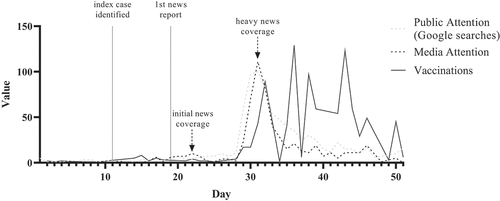Figures & data
Fig. 1. Media attention, public attention (Google searches), and the number of vaccinations during the measles outbreak in Austria in 2019. The observation period is N = 51 days (Day 1 = January 1 to Day 51 = February 20). The figure provides untransformed raw data. For vaccinations, there were no data on some days (see the methods section); the graph connects adjacent points.

Fig. 2. Fitted lognormal distribution functions of a measles outbreak’s effect on media attention, public attention (Google searches), and vaccinations. The vertical dashed lines represent the geometric mean. The dotted curves indicate the confidence band (95%) of the fitted lognormal distribution function.

